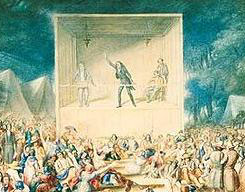Great Awakening
‘Great Awakening’ is a term religious
historians use to describe various periods of religious revivals in American society. The three key waves of the
Great Awakening were led by evangelical Protestant ministers who were motivated by a profound sense of conviction
and motivation.
First
Awakening
The First Awakening was a Christian
revitalization movement that that swept Protestant Europe and the American colonies (~1730-1740). While
downplaying traditional ritual and ceremony, the First Awakening gave listeners a sense of personal revelation of
their need of salvation by Jesus Christ. It encouraged a commitment to a new
standard of personal morality and spiritual conviction. It brought
Christianity to African slaves and was a monumental event in New England that
challenged established authority. It incited rancor and division between old traditionalists who insisted on the
continuing importance of ritual and doctrine, and the new revivalists, who encouraged emotional involvement,
personal commitment and an intense love for God. It had a major impact in reshaping the Congregational church, the
Presbyterian church, the Dutch Reformed Church, and the German Reformed denomination, and strengthened the small
Baptist and Methodist denominations.
Second Awakening

The Second Awakening reached out to the
unchurched population (~1800-1870). It stimulated the establishment of many reform movements designed to
remedy the evils of society before the Second Coming of Jesus Christ. New denominations included the Churches
of Christ, Christian Church (Disciples of Christ), The Church of Jesus Christ of Latter-day Saints (the Mormons),
the Seventh-day Adventist Church, the Cumberland Presbyterian Church and the Evangelical Christian Church in
Canada.
It expressed an Arminian theology, by which
every person could be saved through revivals, and the desire to restore a purer form of Christianity. To the early
19th-century immigrants America seems to be a perfect place to recover a pure, uncorrupted and original
Christianity. They saw the tradition-bound European churches to be out of place in the new
country.
The Second Awakening also influenced the
Restoration Movement led by Thomas and Alexander Campbell and Barton W. Stone.
Third
Awakening
The Third Awakening was a period of religious
activism in American history from the late 1850s to the early 1900s. It affected pietistic Protestant denominations and had a strong sense of social activism. It preached
postmillennial theology that the Second Coming of Christ would come after mankind had reformed the entire earth. A
major component was the Social Gospel Movement, which applied Christianity to social issues (ie, Jane Addams’s Hull House, Chicago). New groupings emerged, such as the Holiness and Nazarene
movements, and Christian Science, introduced by Mary Baker Eddy, which
gained a national following. The Salvation Army denomination began in 1880 whose mission was to assist the
poor.
| 